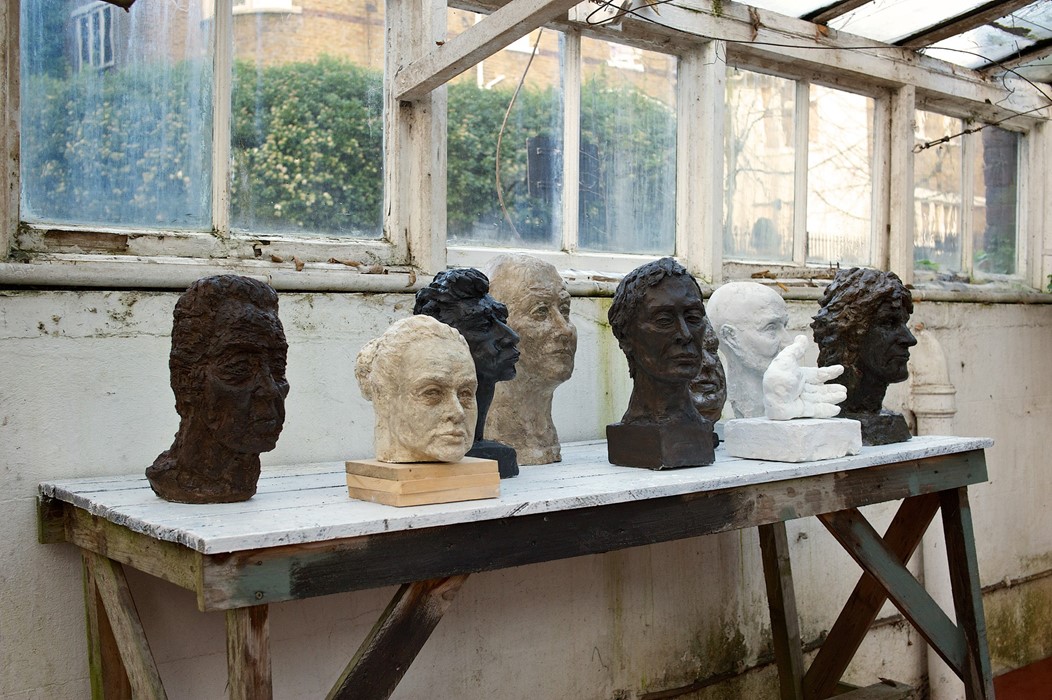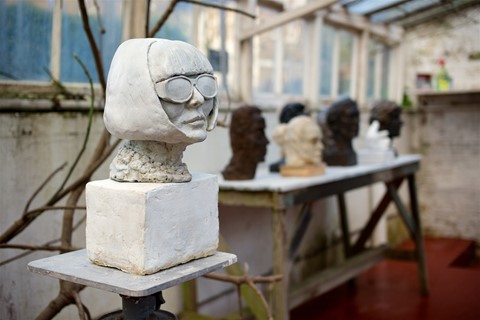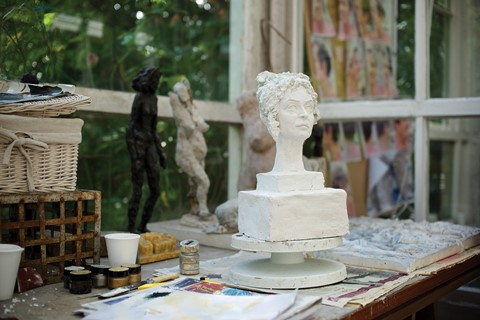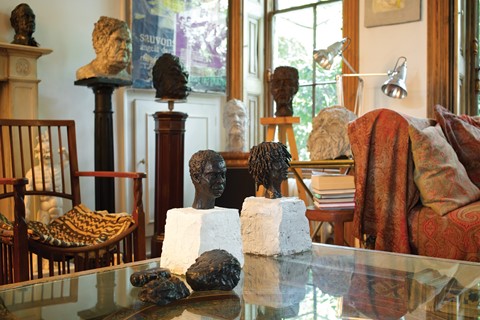In 2013 Nicole Farhi quit fashion and began life as a full-time sculptor – here, she discusses this transition and her new exhibition, Heads and Hands
Sudbury is a small market town in Suffolk, known for being the birthplace of Thomas Gainsborough, the 18th-century painter whose former home operates today as a museum and art gallery.
In 2015 French designer-turned-sculptor Nicole Farhi produced a bronze bust of Gainsborough for the house – which, four years on, forms part of a new exhibition there, titled Nicole Farhi: Heads and Hands.
Here, busts of sculptor and former mentor Eduardo Paolozzi and legendary American Vogue editor-in-chief Anna Wintour, a friend of Farhi, sit alongside sculptures of hands belonging to dancers, musicians, and her mother. At the same time, London’s Beaux Arts gallery is hosting another exhibition of Farhi’s sculptures titled Folds. In this show, the rounded curves of a woman’s body pull focus: a pair of legs kneeling, the cupped breast of Lucian Freud muse Sue Tilley, a back with creases.
It’s a contrast to the work she was producing for her eponymous label which – celebrated for its laidback luxury – ran from 1982 to 2013, when it sadly ran into administration. Here, Farhi reflects on her departure from fashion and her new life as a sculptor.
You left fashion in 2013. Was that a relief?
Nicole Farhi: I wouldn’t say relief. I had done it, I was happy to have done it, I was happy to turn the page and sculpt. I didn’t feel [deep sigh]... I had a fashion show, I knew it would be the last one, and the next morning I was in the studio.
Why then specifically?
NF: My company had been sold, I had a contract to stay two more years. If it had been sold ten years before I would have stayed two years and left, or if it had been sold five years later I probably would have carried on. It was difficult – it is even more difficult now to be in fashion – but it was not the reason I left.
Do you reflect on your fashion career ever?
NF: No, never. It’s something I did. I had some really good times – we had incredibly exciting years in the 70s with French Connection. We travelled, I discovered India, China and Japan. My team was wonderful – I still see them – but I’m doing something else.
Do you pay attention to the industry today?
NF: Not at all.
Was it easy to adjust to your new life?
NF: I’ve been sculpting for the 35 years so, instead of sculpting three days a week I was sculpting seven.
How did you first get into it?
NF: Through a friend at a dinner party. She was a sculptor and I thought maybe I should try that, because painting I did a bit, but probably was not good enough at. I went to Jean Gibson, my first teacher, she gave me a lump of clay and I could do something with it immediately and I knew, it touched something for me that would be important.
Did you ever think you’d be doing it full-time?
NF: I was so happy sculpting, I thought maybe one day, but it took me 35 years.
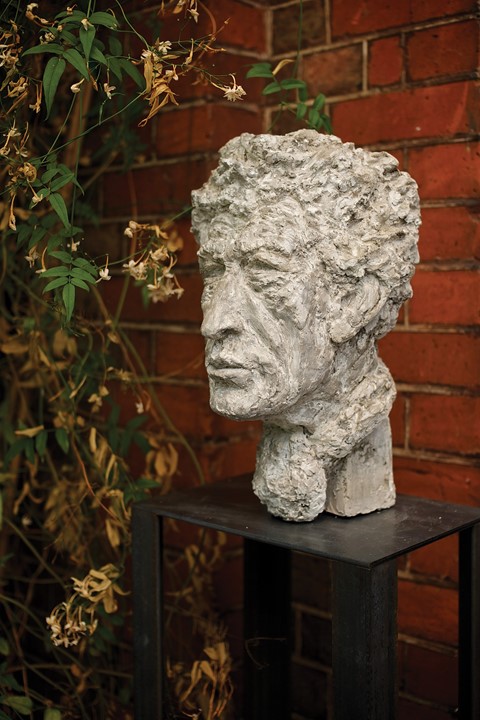
How, if at all, does coming to it after fashion – as a secondary career perhaps – affect what you produce?
NF: You don’t think ‘I’m having a career’ when you do something. At the end when you might look back; at the moment I’m sculpting and having a wonderful time. I will sculpt until I die, I know that, unless something happens to me. You build a career over years and years. It’s only people who say I have a career – for me, I’m sculpting. But what is a career, I don’t know.
You’re currently showing in London and Sudbury. What led you to exhibit publicly?
NF: By chance. A friend who has a gallery looked at the work I had been doing and said ‘Why don’t you show it? Other people might like what you’re doing.’ I didn’t know anybody in that world, but he sent Robert Bowman and immediately he said I’ll give you a show. So, I left fashion and a year later I had a show, then a second two years after, my third in London, and now this is happening. Then three more shows this year. It’s suddenly... people are interested.
Is it nice, people discussing your work?
NF: It’s wonderful to get feedback. In fashion I didn’t work for myself. Somebody said to me ‘I’m so moved when I look at your mother’s hands.’ That’s what you want, people to be moved or excited – like it or don’t, but have a reaction. If you don’t show, you never get that.
Sue Tilley modelled for Folds. How did that happen?
NF: I wanted large women. I asked a friend and she said I know one person but she’s no longer a model, it’s Susan Tilley. Sue was intrigued. She had done the portrait of Freud and said ‘Freud was the only person I sat for’. I explained that I was going to do fragments, not the whole body, so she said: ‘I’m only going to show you my breast.’ Fine, because the breast is the beginning of humanity. I did her breast, she loved it – it’s called Gaia, the name of the goddess of the earth. And then she had a friend who sat. She was a professional model, but she also teaches photography, so those women knew – because they’re artists – how to sit and express exactly what I was looking after. We had a wonderful exchange. I wanted Folds to talk about the weight of the body, the power large women have, and the sensuality.
Why are you interested in portraying larger women?
NF: It’s an antidote to what I’ve done before. When you are in fashion, they only show slim girls, I wanted to show the beauty elsewhere, when you have folds in your body, how beautiful these are. I wanted to do things that people don’t think about, and I’ve not done. And it’s a language, sculpture, you talk with your hands and you say things that should not need any words.
And here you’ve been drawn to hands...
NF: Hands and faces are really the two portraits of a human being. I look at you and I look at your hands as we’re talking, the two animated parts of you that are saying a lot. The voice is very important. I have a friend, an opera singer, and I always say I’m going to do your voice one day. How, I haven’t a clue – it’s going to be abstract – but the voice is very important. The head, the voice, the hands, it’s a complete image of the person.
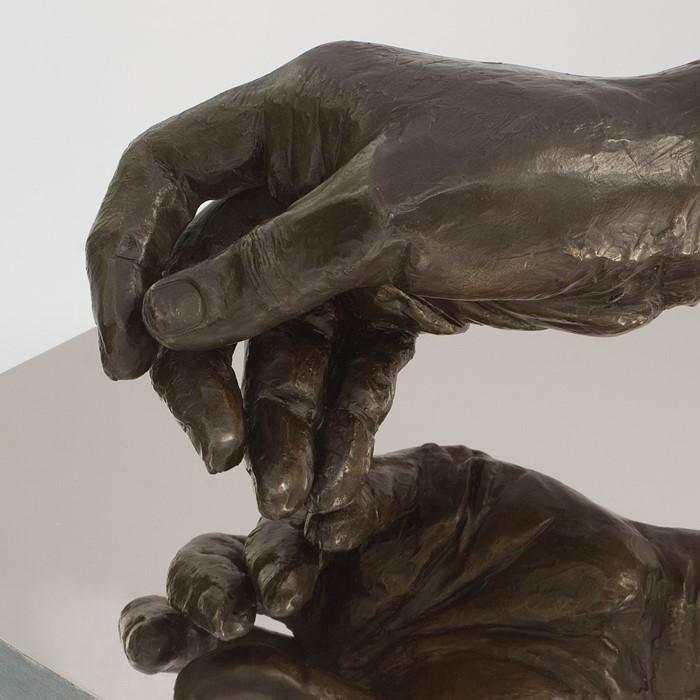
Folds is at Beaux Arts, London, until March 2, 2019.
Nicole Farhi: Heads and Hands is at Gainborough’s House, Sudbury, until Jun 16, 2019.
